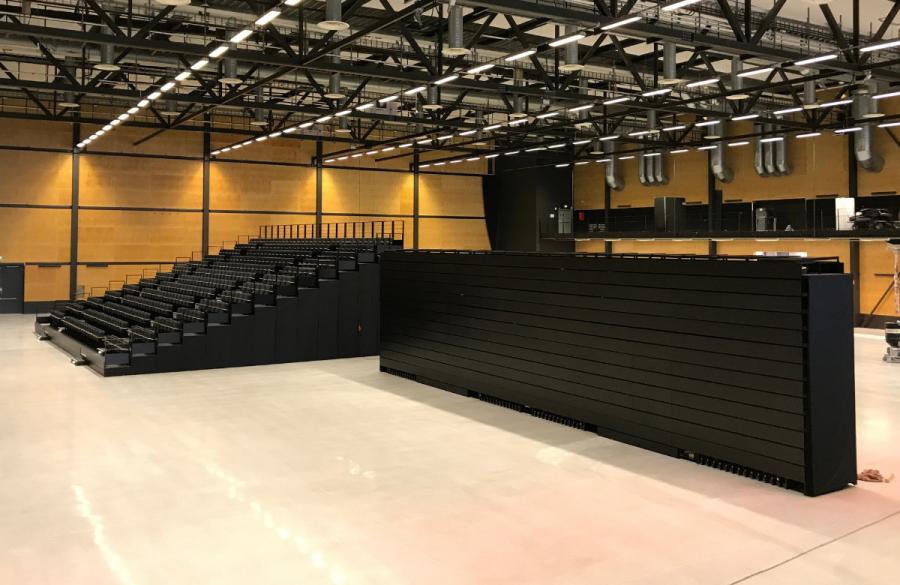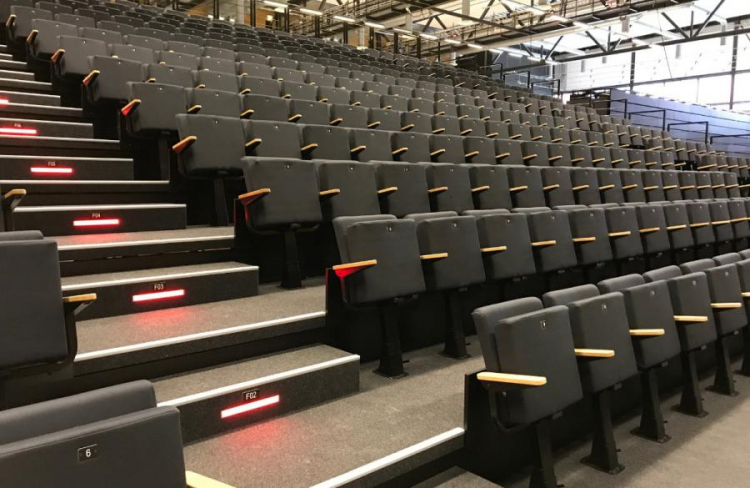We’ve written before about the versatility and practicality of modular seating, and the ways in which it can be used to transform a single space into a multi-purpose venue. As a leading provider of retractable seating systems for a wide variety of venues we’re constantly working to improve and enhance the service we offer.
In simple terms this means refining the technology in a way which maximises the flexibility of modular seating, making it simpler to use and offering a quicker transformation of any seating configuration without compromising on safety, quality or comfort. Our innovative Eureka system offers all of this and more, and the virtues offered by a system which is based on the use of friction wheels rather than being chain driven are perhaps best illustrated, in the first instance, by a consideration of how a more traditional chain system works, and the problems which these systems tend to present.
Alternative Telescopic Seating Systems
In the majority of cases, the chain system operates as part of a telescoping bleacher seating system which, when not in use, can be collapsed in on itself to create a flat unit which can be stored and which opens up the floor space previously occupied by the seating. Whether the system in question utilises bench seating or individual seating units, the rows of seating will be supported by a framework based around posts which extend vertically from the base to support each row of seats, with each row positioned higher than the one in front. The retractable stands can then be fitted with customisable accessories such as end railings, floor coverings and illumination, but the comparison between the chain and friction wheel system is based upon the basic structure of the stand. The supports upon which the seats rest are mounted on a base which is, itself, mounted on wheels, and it is these wheels which allow the rows of seats to be shifted in and out as and when needed.
The non-friction, chain driven version of a system such as this operates via a drive mechanism located at the rear of the structure. This unit powers an extendable chain which drives the base of the unit in and out as the telescopic seating is extended or collapsed. It is the use of a chain to undertake a high stress, weight intensive operation such as this which causes most of the problems associated with non-friction systems.
What To Look Out For
The first of these problems is that it is very difficult, once the chain has started to extend the unit, to maintain the kind of straight line needed for successful extension. In simple terms, the further the system is extended, the more likely it is that the chain will cause the front row or rows to skew out of line. Trying to avoid this non-linear extension involves extremely careful adjustment and operation of the chain itself, and no matter how carefully the chain is operated there is still a chance that the pressure placed on the furthest extent of the chain – where it is at its weakest – will still cause misalignment.
The second major problem facing anyone operating a traditional chain drive system is the complexity of that system and, as a result, the level of maintenance and adjustment required. The pressures placed on a chain operating a large-scale section of seating are such that the chain system itself requires virtually constant maintenance in order to ensure that it continues to operate safely. Not only does this increase the time it takes to reconfigure any section of seating it also means the cost of upkeep rises sharply, reducing the return on investment which any chain driven telescoping seating is able to deliver. This is an important point to bear in mind, as the overriding impulse behind investing in retractable seating systems tends to be a desire to maximise the revenue a specific venue can generate. This usually translates as the ability to reconfigure for the widest possible range of uses – from sporting events to theatrical presentations and conference facilities. If the system that provides such versatility requires constant monitoring and maintenance from qualified personnel then the extra revenue the seating is supposed to generate will constantly be eaten into.
Perhaps the biggest drawback of a chain driven system of the type traditionally installed is the safety risk it presents. Moving components such as chains and sprockets represent a danger in terms of catching the fingers of those tasked with operating the system. If any operative’s fingers are caught in a system of this kind – despite any safety mechanisms which may be in place – the damage caused could be severe long before any evasive action is able to be taken.

The Advantages Of A Friction Wheel System
The friction wheel system offers all of the advantages of telescoping seating without the disadvantages of chain operation outlined above. The first advantage which a system such as Eureka offers over a chain driven system is the improvement on the return on investment it provides. This is because, no matter what the price of the unit is initially, the lower maintenance required will cut the cost of upkeep on a day to day basis, and the same kind of savings are presented by the huge reduction in the number of people needed to put the stand in place.
Time Savings
Whereas a traditional scaffold based system might need a team of 20 people working over a period of five days to construct it and put it in place, a friction wheel system will only need a team of six capable of assembling and disassembling a system of the same scale over the course of a single day. What this means is that a much higher percentage of the extra income generated by the flexibility and versatility of the retractable seating will emerge as profit rather than being recycled as labour costs. With a system which can quickly and simply transform from a four sided arena set up to an in-the-round construction or a semi-circle auditorium scenario, the possibilities for a single space are virtually limitless, and one venue can serve clients from the widest possible range of sectors.
No Lifting Required
Whereas shifting a chain driven system is a laborious and time consuming task, friction wheel stands rotate easily without having to be lifted. The hundreds of wheels on the base of the stands stay in contact with the floor throughout, distributing the weight of the stand evenly and minimising the pressure placed on the flooring. This is better for the condition of the floor itself at the same time as being safer for the operatives, who are able to shift full scale, multi-seat stands using a single remote control, while the fact that no specialist lifting equipment is needed will lower the operational costs of the seating. Although the first and last rows of a friction wheel stand will be parallel the vast majority of the time, a laser guidance system can be utilised to double check, a process which hugely undercuts the maintenance and adjustments required with a chain driven system.
Remote Control Movement
Once in motion, a friction wheel stand can be steered precisely via remote control, and can therefore be shifted with inch perfect precision. If the stand encounters an obstacle on the floor it can be steered around it manually using the remote control or automatically via the laser system. In both cases the steerable stand will be able to keep moving whilst avoiding damaging the floor through the rotation of wheels while the stand is physically unable to move.
Unlike the simple backward and forward motion of a chain driven stand, the Eureka system, once closed, can move backward and forward or side by side, at the same time as rotating through 360°. The replacement of chain driven technology with the friction wheel alternative creates a seating system which is simultaneously safer and more stable, while at the same time offering greater flexibility, speed of application and a lower long term running cost.











 © 2025 All rights reserved.
© 2025 All rights reserved.